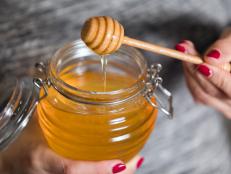Is Canned Fish Healthy?
Here's what you need to know about adding canned fish products to your diet.

Matt Armendariz, 2014, Television Food Network, G.P. All Rights Reserved
Get the Recipe: Salmon Cakes with Creamy Ginger Sesame Sauce
Have those cans of tuna and salmon been sitting in your pantry for a while? These days, many folks have been stocking up on canned fish to help minimize trips to the grocery store. If you’re worried about eating what’s in those cans, you really don’t have to be.
The Benefits of Canned Fish
Canned fish isn’t just tuna and salmon. You can find shrimp, sardines, clams and crabmeat in cans too! Canned fish provides protein and is convenient, nutritious and delicious. Protein is an essential nutrient for building and maintaining the body’s tissues and muscles. According to a Survey of Consumer Perceptions and Consumption of Canned Protein Foods by the Canned Manufacturers Institute, 9 in 10 Americans use canned beans, chicken or fish as a convenient source of protein.
Canned fish, including salmon and tuna, have more nutrients than just protein. According to Elana Natker, MS, RD and director of consumer and healthcare practitioner outreach for GOED, “I always recommend canned tuna and salmon, since most people aren’t eating nearly enough fish in their diets.” Natker points out that according to the latest data, average fish intake per person is less than 5 ounces per week, which is still below the 8 ounces per week recommended in the Dietary Guidelines for Americans. “What’s more, you should be choosing fish that provides measurable amounts of EPA and DHA omega-3s, fatty acids that are important for a healthy heart, brain and eyes,” explains Natker. The five ounces of fish people are eating includes shrimp and tilapia, popular fish that are still healthy but don’t provide many omega-3s. Canned tuna is a good source of EPA and DHA omega-3s, and canned salmon, because it’s an oilier fish, is even better.
Most Cans Are BPA-Free
If you’re worried about bisphenol A (BPA) lining the cans, more than 95% of food can production has moved away from using it. New safe and effective can linings are being used. Today, the lining in the cans are typically made from acrylic, polyester, non-BPA epoxies or olefin polymers, which have never been suspected to have endocrine activity (a concern of BPA). In addition, the lining of the cans are also selected to act as strong barriers, which helps prevent foodborne illness. There has not been a single report of foodborne illness from the failure of metal packaging in over 40 years.
Steel cans are 100% recyclable, over and over again, forever. According to the Cans Get You Cooking website, new steel produced using recycled cans reduce greenhouse gas emissions by 75%.
Watch Sodium and Fat Levels
One concern about canned food is the sodium content. Although your body needs only a small amount of sodium to properly function, too much sodium can be bad for your health. According to the 2015-2020 dietary guidelines, overdoing it on sodium can increase the risk of high blood pressure, which is a major cause of stroke and heart disease. Three ounces of drained chunk light tuna packed in water provides 12% of the recommended daily maximum of sodium.
Also, consider the amount of fat in some canned fish. Fish can be packed in water or in oil. If you’re looking to cut back on calories or watch your weight, canned fish packed in oil provides more calories. Instead opt for canned fish packed in water.
Bottom Line
Canned fish is healthy all the way! With canned fish brimming with nutrients and the lining of the can being update by the canned food industry, there is no reason not to include this healthy food into your diet.
Toby Amidor, MS, RD, CDN, is a registered dietitian and consultant who specializes in food safety and culinary nutrition. She is the author of The Greek Yogurt Kitchen: More Than 130 Delicious, Healthy Recipes for Every Meal of the Day.
*This article was written and/or reviewed by an independent registered dietitian nutritionist.
Related Links


































